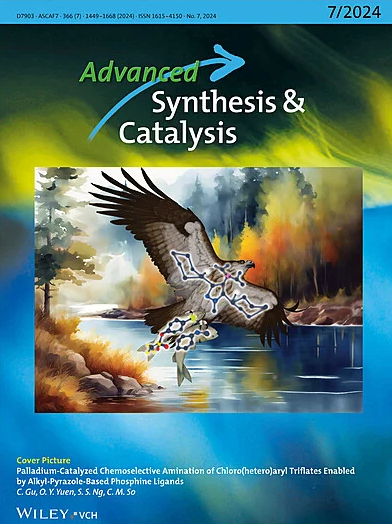光诱导结合硼酸基介导的有机卤化物功能化
IF 4
2区 化学
Q2 CHEMISTRY, APPLIED
引用次数: 0
摘要
卤素原子转移(XATs)代表了一类有价值的反应,可以促进烷基和芳基卤化物中C - X键的功能化。从历史上看,这些转化依赖于锡基或硅基试剂,这些试剂受到一些缺点的困扰,包括毒性,复杂的合成和高成本。针对这些限制,最近出现了连接硼烷作为一种更环保的替代品,通过生成反应性硼基自由基作为有效的卤素萃取剂。这种方法能够从卤化物前体中选择性和直接地形成烷基和芳基自由基,为广泛的化学转化打开了大门。本文综述了结扎硼基自由基介导的XAT化学的最新进展,重点介绍了各种可接近的反应、潜在的机制以及获得的机制见解。据作者所知,这是第一个致力于硼酸基介导的XAT过程的综合综述。随着合成化学家对这一领域的兴趣日益浓厚,作者旨在为研究人员和学生提供当前进展的清晰概述,并激发未来对结扎硼基自由基化学的探索。本文章由计算机程序翻译,如有差异,请以英文原文为准。
Photoinduced Ligated Boryl Radical‐Mediated Functionalization of Organic Halides
Halogen atom transfers (XATs) represent a valuable class of reactions that facilitate the functionalization of CX bonds in alkyl and aryl halides. Historically, these transformations relied on tin‐ or silicon‐based reagents, which are plagued by several drawbacks, including toxicity, complex synthesis, and high costs. In response to these limitations, ligated boranes have recently emerged as a greener alternative, functioning as efficient halogen abstractors through the generation of reactive boryl radical species. This approach enables the selective and straightforward formation of alkyl and aryl radicals from their halide precursors, opening the door to a wide range of chemical transformations. This review highlights the most recent progress in ligated boryl radical‐mediated XAT chemistry, focusing on the variety of accessible reactions, the underlying mechanisms, and the mechanistic insights gained. To the best of the authors’ knowledge, this is the first comprehensive review dedicated to boryl radical‐mediated XAT processes. With growing interest in this area among synthetic chemists, the authors aim to provide both researchers and students with a clear overview of current advancements and inspire future exploration of ligated boryl radical chemistry.
求助全文
通过发布文献求助,成功后即可免费获取论文全文。
去求助
来源期刊

Advanced Synthesis & Catalysis
化学-应用化学
CiteScore
9.40
自引率
7.40%
发文量
447
审稿时长
1.8 months
期刊介绍:
Advanced Synthesis & Catalysis (ASC) is the leading primary journal in organic, organometallic, and applied chemistry.
The high impact of ASC can be attributed to the unique focus of the journal, which publishes exciting new results from academic and industrial labs on efficient, practical, and environmentally friendly organic synthesis. While homogeneous, heterogeneous, organic, and enzyme catalysis are key technologies to achieve green synthesis, significant contributions to the same goal by synthesis design, reaction techniques, flow chemistry, and continuous processing, multiphase catalysis, green solvents, catalyst immobilization, and recycling, separation science, and process development are also featured in ASC. The Aims and Scope can be found in the Notice to Authors or on the first page of the table of contents in every issue.
 求助内容:
求助内容: 应助结果提醒方式:
应助结果提醒方式:


